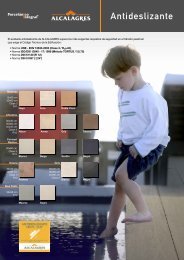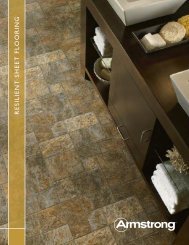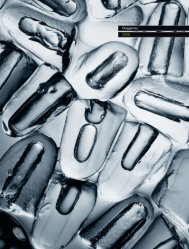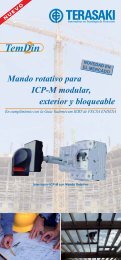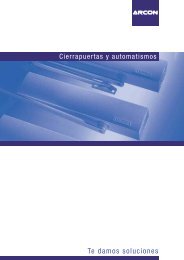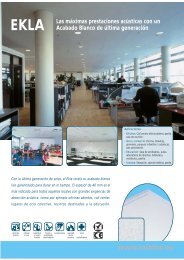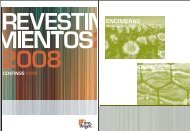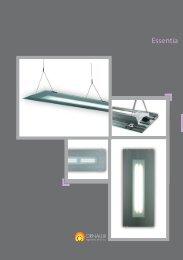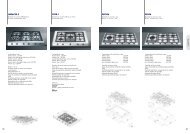manual de colocación de baldosas cerámicas - Habitissimo
manual de colocación de baldosas cerámicas - Habitissimo
manual de colocación de baldosas cerámicas - Habitissimo
Create successful ePaper yourself
Turn your PDF publications into a flip-book with our unique Google optimized e-Paper software.
Grouting materials:<br />
> CEMENT GROUTING MATERIALS<br />
> Portland cement grout (with or<br />
without sand)<br />
These grouts may be ma<strong>de</strong> with gray or white<br />
cement and are applied at a width of up to 3<br />
mm. Grouts are ma<strong>de</strong> with pure cement and<br />
ad<strong>de</strong>d sand in varying proportions of between<br />
1:1 and 1:3 <strong>de</strong>pending on the width of the joint.<br />
Class CG1 according to EN 13888. They are not<br />
recommen<strong>de</strong>d as there are specific grouting<br />
products on the market with much better<br />
performance specifications. They are especially<br />
unsuitable for floors due to their limited<br />
impermeability.<br />
> Cement-glue mortars.<br />
These are ready-ma<strong>de</strong> products with a cement<br />
base, sand, synthetic resins and other additives<br />
that improve water-retaining capacity. They can<br />
be used with good results both indoors and out,<br />
but they have a low resistance to acids and<br />
bases and so should not be used in areas where<br />
they may be subject to chemical attack. Classes<br />
CG2 and CG2W according to EN 13888.<br />
> Latex cement mortars.<br />
Elastic latex is used in the preparation of the<br />
mortar instead of a water mixer. Care must be<br />
taken at all times over the amount of the mix.<br />
These mortars result in joints that are more<br />
compact and less porous than those achieved<br />
with cement-glue mortars. They are also easier<br />
to clean, are easy to <strong>de</strong>form and are highly<br />
resistant to abrasion. They are used both indoors<br />
and out and are especially recommen<strong>de</strong>d in<br />
situations where an impermeable and elastic<br />
joint is required. Class CG2ArW according to<br />
EN 13888.<br />
ADVANTAGES DRAWBACKS<br />
USES<br />
> Aesthetic > Not impermeable<br />
> Indoor floors<br />
> High shrinkage<br />
> Not suitable for joints more<br />
than 1.5 mm wi<strong>de</strong><br />
> Indoor walls<br />
> Easy to use<br />
> High adhesion<br />
> Durability<br />
> Resistance to immersion<br />
> Deformability<br />
> High adhesion<br />
> Impermeability<br />
> Mechanical resistance<br />
GROUTING MATERIALS BASED ON REACTIVE RESINS<br />
> Materials with organic bases<br />
These are products based on the use of silicon<br />
rubber, polyurethane or various resins (furan,<br />
epoxi<strong>de</strong>, and other resins) They are sold ready<br />
for use or in preparations requiring two<br />
components to be mixed. Those ma<strong>de</strong> with<br />
silicons or polyurethanes produce highly elastic<br />
joints. They are all extremely resistant to chemical<br />
attack, especially those ma<strong>de</strong> with furan or<br />
epoxi<strong>de</strong> resins, making them suitable for use in<br />
industrial premises, laboratories and areas subject<br />
to harsh chemical attack. Class RG according<br />
to EN 13888.<br />
> Ready for use<br />
> Chemical resistance<br />
> Mechanical resistance<br />
> Impermeability<br />
> Limited resistance to abrasion<br />
> Quantities of the components<br />
must be measured<br />
ADVANTAGES DRAWBACKS<br />
USES<br />
> Meticulous handling<br />
> Indoor floors<br />
> Outdoor floors<br />
> Indoor walls<br />
> Outdoor walls<br />
> Indoor floors<br />
> Outdoor floors<br />
> Indoor walls<br />
> Outdoor walls<br />
> Indoor floors<br />
> Outdoor floors<br />
> Indoor walls<br />
> Outdoor walls<br />
11




